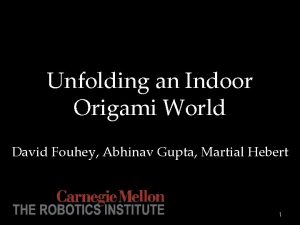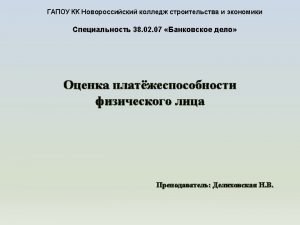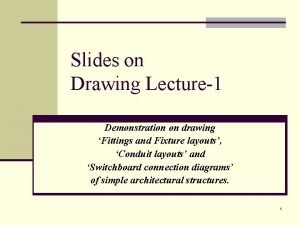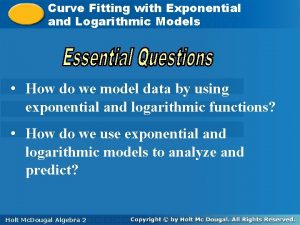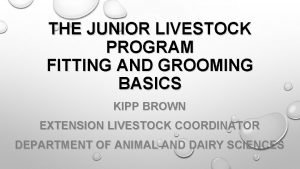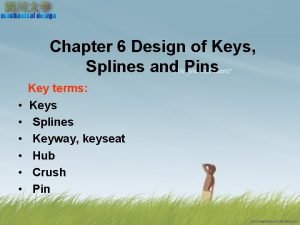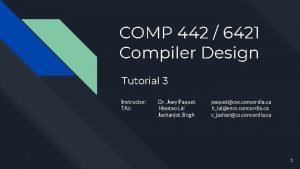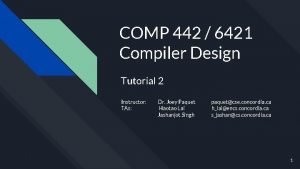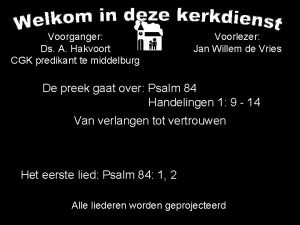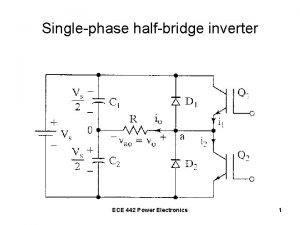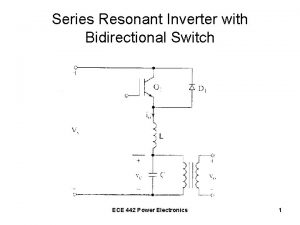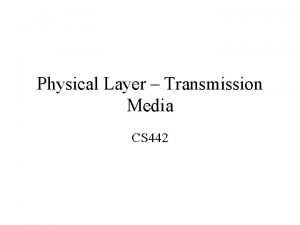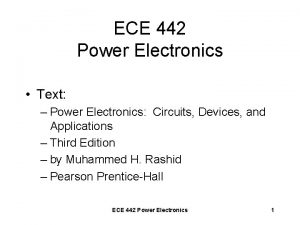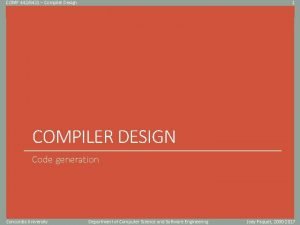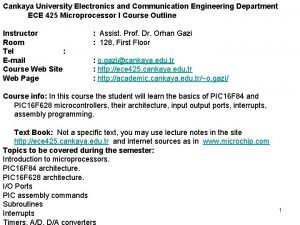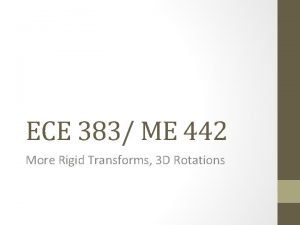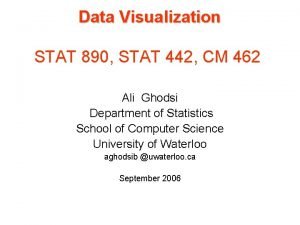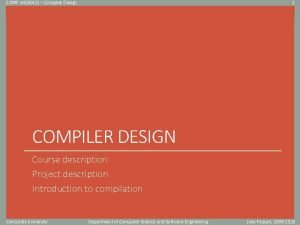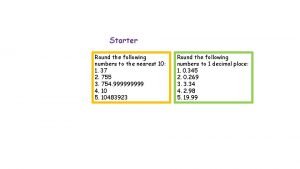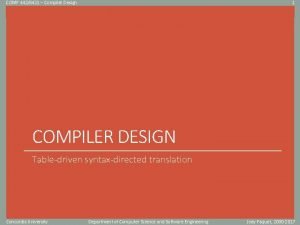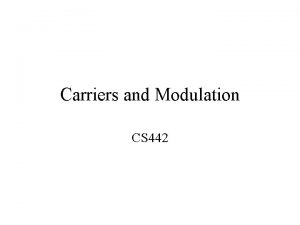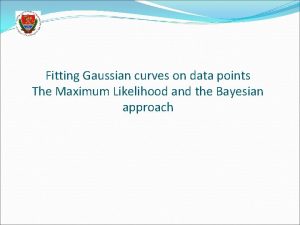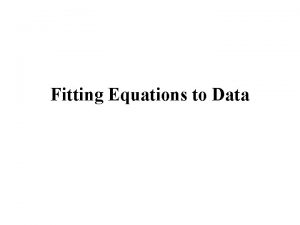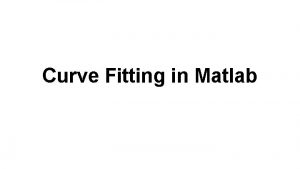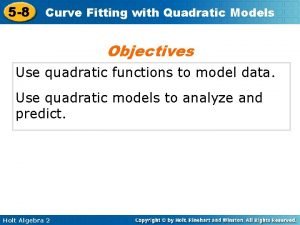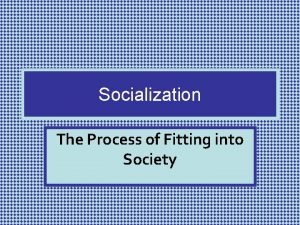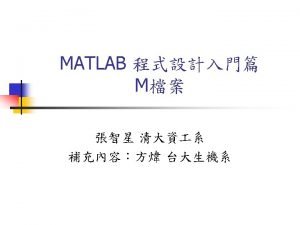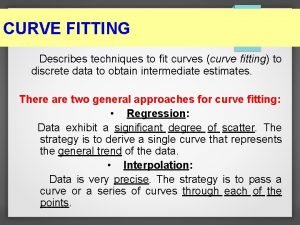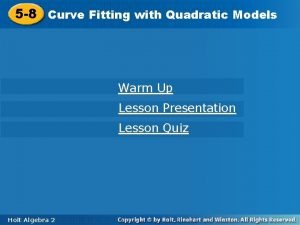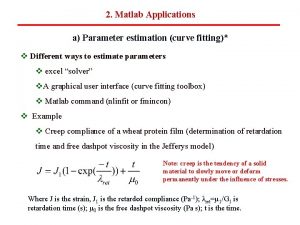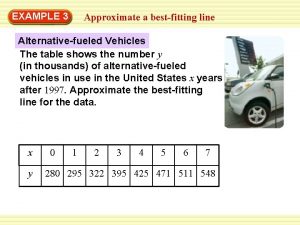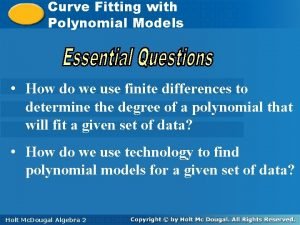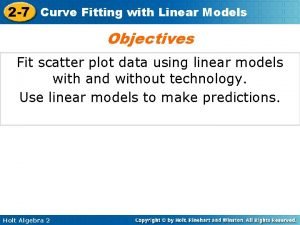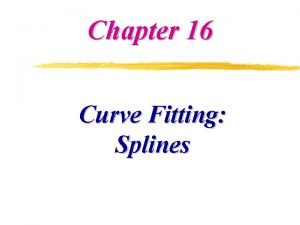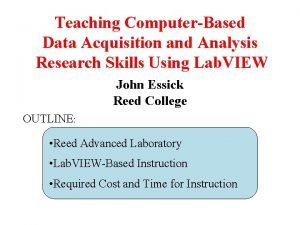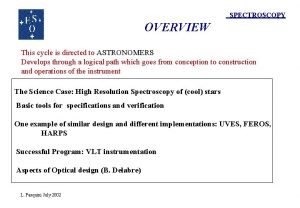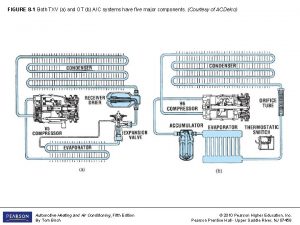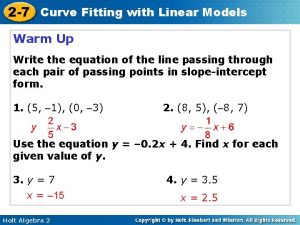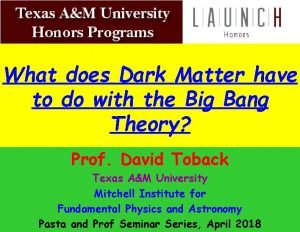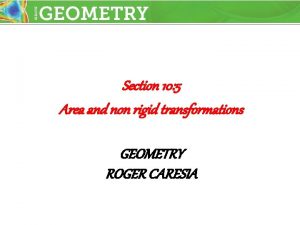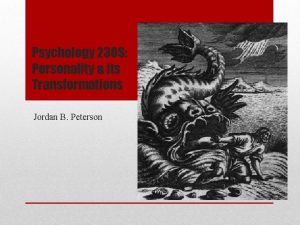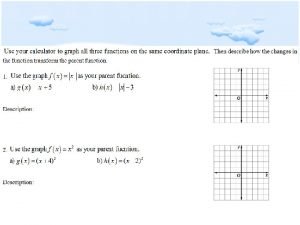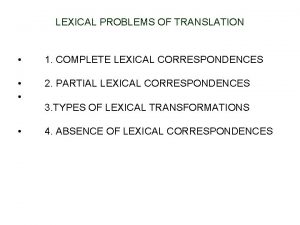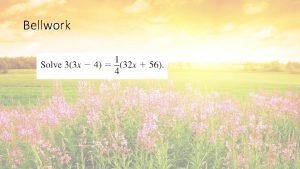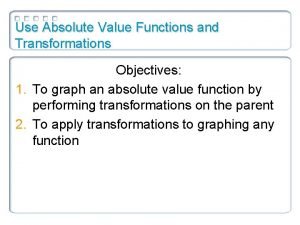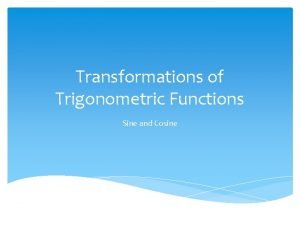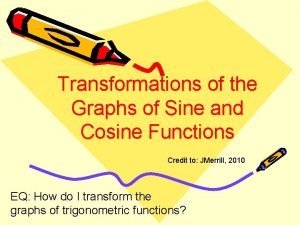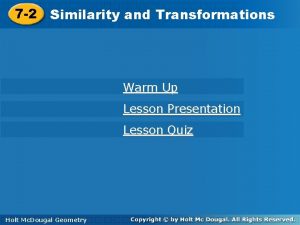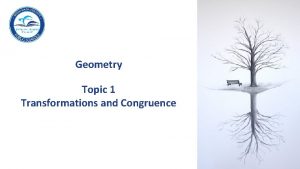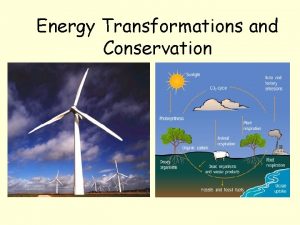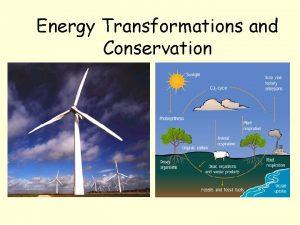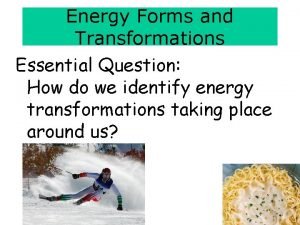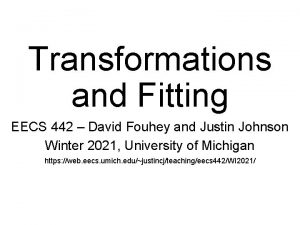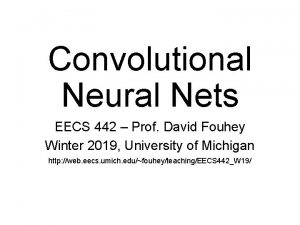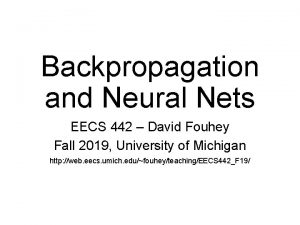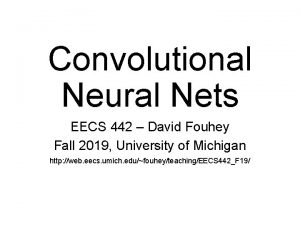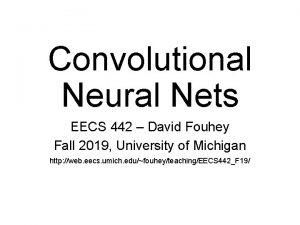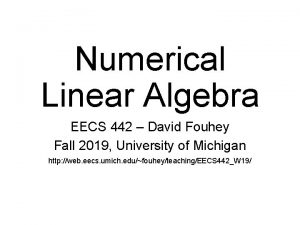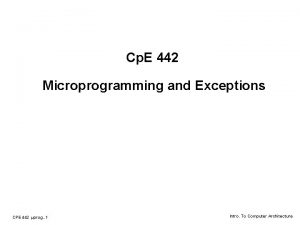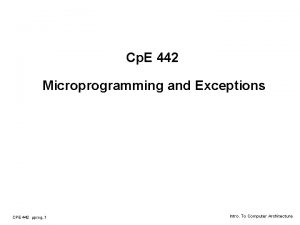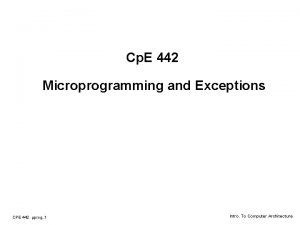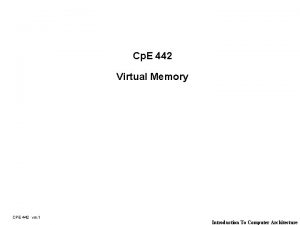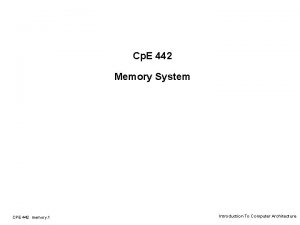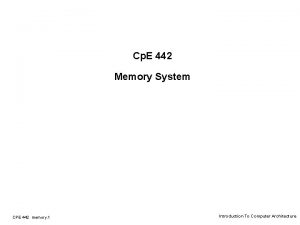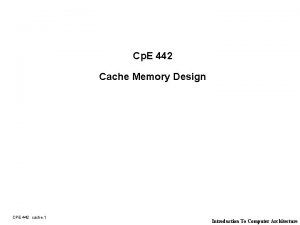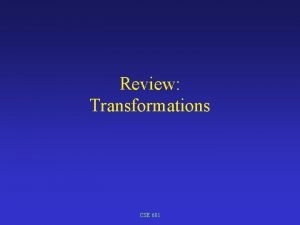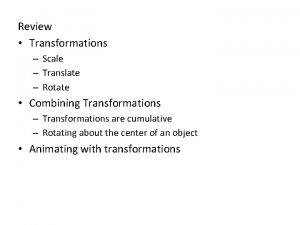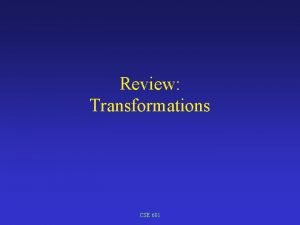Transformations and Fitting EECS 442 Prof David Fouhey




































![Running RANSAC Point/line distance |n. T[x, y] – d| Trial #1 Best Model: None Running RANSAC Point/line distance |n. T[x, y] – d| Trial #1 Best Model: None](https://slidetodoc.com/presentation_image_h2/ad1127fd351aeefe2384aeae6fc2a870/image-37.jpg)
































- Slides: 69

Transformations and Fitting EECS 442 – Prof. David Fouhey Winter 2019, University of Michigan http: //web. eecs. umich. edu/~fouhey/teaching/EECS 442_W 19/

Administrivia • Grading ~80% done • I will post a link to sign up for Amazon AWS resources. • Please sign up ASAP

Last Class 1. How do we find distinctive / easy to locate features? (Harris/Laplacian of Gaussian) 2. How do we describe the regions around them? (Normalize window, use histogram of gradient orientations)

Earlier I promised Solving for a Transformation T 3: Solve for transformation T (e. g. such that p 1 ≡ T p 2) that fits the matches well

Before Anything Else, Remember You, with your gigantic brain, see: The computer sees: You should expect noise (not at quite the right pixel) and outliers (random matches)

Today • How do we fit models (i. e. , a parameteric representation of data that’s smaller than the data) to data? • How do we handle: • Noise – least squares / total least squares • Outliers – RANSAC (random sample consensus) • Multiple models – Hough Transform (can also make RANSAC handle this with some effort)

Working Example: Lines • We’ll handle lines as our models today since you should be familiar with them • Next class will cover more complex models. I promise we’ll eventually stitch images together • You can apply today’s techniques on next class’s models

Model Fitting Need three ingredients Data: what data are we trying to explain with a model? Model: what’s the compressed, parametric form of the data? Objective function: given a prediction, how do we evaluate how correct it is?

Example: Least-Squares Fitting a line to data Data: (x 1, y 1), (x 2, y 2), …, (xk, yk) Model: (m, b) yi=mxi+b Or (w) yi = w. Txi Objective function: (yi - w. Txi)2

Least-Squares Setup Note: I’m writing the most general form here since we’ll do it in general and you can make it specific if you’d like.

Solving Least-Squares Recall: derivative is 0 at a maximum / minimum. Same is true about gradients. Aside: 0 is a vector of 0 s. 1 is a vector of 1 s.

Derivation for the Curious

Two Solutions to Getting W In One Go Iteratively Implicit form (normal equations) Recall: gradient is also direction that makes function go up the most. What could we do? Explicit form (don’t do this)

What’s The Problem? • Vertical lines impossible! • Not rotationally invariant: the line will change depending on orientation of points

Alternate Formulation Recall: Can always rescale l. Pick a, b, d such that

Alternate Formulation Now: Point to line distance:

Total Least-Squares Fitting a line to data Data: (x 1, y 1), (x 2, y 2), …, (xk, yk) Model: (n, d), ||n||2 = 1 n. T[xi, yi]-d=0 Objective function: (n. T[xi, yi]-d)2

Total Least Squares Setup Figure out objective first, then figure out ||n||=1 The mean / center of mass of the points: we’ll use it later

Solving Total Least-Squares First solve for d at optimum (set to 0)

Solving Total Least-Squares Objective is then:

Homogeneous Least Squares Eigenvector corresponding to smallest eigenvalue of ATA Why do we need ||v||2 = 1 or some other constraint? Applying it in our case: Note: technically homogeneous only refers to ||Av||=0 but it’s common shorthand in computer vision to refer to the specific problem of ||v||=1

Details For ML-People Matrix we take the eigenvector of looks like: This is a scatter matrix or scalar multiple of the covariance matrix. We’re doing PCA, but taking the least principal component to get the normal. Note: If you don’t know PCA, just ignore this slide; it’s to help build connections to people with a background in data science/ML.

Running Least-Squares

Running Least-Squares

Ruining Least Squares

Ruining Least Squares

Ruining Least Squares Way to think of it #1: 100^2 >> 10^2: least-squares prefers having no large errors, even if the model is useless overall Way to think of it #2: Weights are a linear transformation of the output variable: can manipulate W by manipulating Y.

Common Fixes Replace Least-Squares objective Let LS/L 2/MSE: L 1: Huber:

Issues with Common Fixes • Usually complicated to optimize: • Often no closed form solution • Typically not something you could write yourself • Sometimes not convex (no global optimum) • Not simple to extend more complex objectives to things like total-least squares • Typically don’t handle a ton of outliers (e. g. , 80% outliers)

Outliers in Computer Vision Single outlier: rare Many outliers: common

Ruining Least Squares Continued

Ruining Least Squares Continued

A Simple, Yet Clever Idea • What we really want: model explains many points “well” • Least Squares: model makes as few big mistakes as possible over the entire dataset • New objective: find model for which error is “small” for as many data points as possible • Method: RANSAC (RAndom SAmple Consensus) M. A. Fischler, R. C. Bolles. Random Sample Consensus: A Paradigm for Model Fitting with Applications to Image Analysis and Automated Cartography. Comm. of the ACM, Vol 24, pp 381 -395, 1981.

RANSAC For Lines best. Line, best. Count = None, -1 for trial in range(num. Trials): subset = pick. Pair. Of. Points(data) line = total. Least. Squares(subset) E = line. Point. Distance(data, line) inliers = E < threshold if #inliers > best. Count: best. Line, best. Count = line, #inliers

Running RANSAC Lots of outliers! Trial #1 Best Model: None Best Count: -1

Running RANSAC Fit line to 2 random points Trial #1 Best Model: None Best Count: -1
![Running RANSAC Pointline distance n Tx y d Trial 1 Best Model None Running RANSAC Point/line distance |n. T[x, y] – d| Trial #1 Best Model: None](https://slidetodoc.com/presentation_image_h2/ad1127fd351aeefe2384aeae6fc2a870/image-37.jpg)
Running RANSAC Point/line distance |n. T[x, y] – d| Trial #1 Best Model: None Best Count: -1

Running RANSAC Distance < threshold 14 points satisfy this Trial #1 Best Model: None Best Count: -1

Running RANSAC Distance < threshold 14 points Best Model: Trial #1 Best Count: 14

Running RANSAC Distance < threshold 22 points Best Model: Trial #2 Best Count: 14

Running RANSAC Distance < threshold 22 points Best Model: Trial #2 Best Count: 22

Running RANSAC Distance < threshold 10 Best Model: Trial #3 Best Count: 22

Running RANSAC Trial #3 … Best Model: Best Count: 22

Running RANSAC Distance < threshold 76 Best Model: Trial #9 Best Count: 22

Running RANSAC Distance < threshold 76 Best Model: Trial #9 Best Count: 76

Running RANSAC Trial #9 … Best Model: Best Count: 76

Running RANSAC Distance < threshold 22 Best Model: Trial #100 Best Count: 85

Running RANSAC Final Output of RANSAC: Best Model

RANSAC In General best, best. Count = None, -1 for trial in range(NUM_TRIALS): subset = pick. Subset(data, SUBSET_SIZE) model = fit. Model(subset) E = compute. Error(data, line) inliers = E < THRESHOLD if #(inliers) > best. Count: best, best. Count = model, #(inliers) (often refit on the inliers for best model)

Parameters – Num Trials r is the fraction of outliers (e. g. , 80%) Suppose we pick s points (e. g. , 2) we run RANSAC N times (e. g. , 500) What’s the probability of picking a sample set with no outliers? (4%) What’s the probability of picking a sample set with any outliers? (96%)

Parameters – Num Trials r is the fraction of outliers (e. g. , 80%) Suppose we pick s points (e. g. , 2) we run RANSAC N times (e. g. , 500) What’s the probability of picking a sample set with any outliers? (96%) What’s the probability of picking only sample sets with outliers? (10 -7% N=500) (13% N=50) What’s the probability of picking any set with inliers?

Parameters – Num Trials P($157 M Jackpot): 1 / 302, 575, 350 Death by vending machine P(Death): ≈1 / 112, 000 RANSAC fails to fit a line with 80% outliers after trying only 500 times P(Failure): 1 / 731, 784, 961 Odds/Jackpot amount from 2/7/2019 megamillions. com, unfortunate demise odds from livescience. com

Parameters – Num Trials r is the fraction of outliers (e. g. , 80%) Suppose we pick s points (e. g. , 2) we run RANSAC N times (e. g. , 500)

Parameters – Subset Size • Always the smallest possible set for fitting the model. • Minimum number for lines: 2 data points • Minimum number of planes: how many? • Why intuitively? • You’ll find out more precisely in homework 3.

Parameters – Threshold • Common sense; there’s no magical threshold

RANSAC Pros and Cons Pros 1. Ridiculously simple 2. Ridiculously effective 3. Works in general Slide credit: S. Lazebnik Cons 1. Have to tune parameters 2. No theory (so can’t derive parameters via theory) 3. Not magic, especially with lots of outliers

Hough Transform Slide credit: S. Lazebnik

Hough Transform 1. Discretize space of parametric models 2. Each pixel votes for all compatible models 3. Find models compatible with many pixels Slope Intercept Image Space 1 1 0 0 0 2 4 3 0 1 2 0 0 1 Parameter Space Image Space P. V. C. Hough, Machine Analysis of Bubble Chamber Pictures, Proc. Int. Conf. High Energy Accelerators and Instrumentation, 1959 Slide credit: S. Lazebnik

Hough Transform Line in image = point in parameter space m y x Image Space b Parameter Space Diagram is remake of S. Seitz Slides; these are illustrative and values may not be real

Hough Transform Point in image = line in parameter space All lines through the point: m y x Image Space b Parameter Space Diagram is remake of S. Seitz Slides; these are illustrative and values may not be real

Hough Transform Point in image = line in parameter space All lines through the point: m y x Image Space b Parameter Space Diagram is remake of S. Seitz Slides; these are illustrative and values may not be real

Hough Transform Point in image = line in parameter space All lines through the point: y m If a point is compatible with a line of model parameters, what do two points correspond to? x Image Space b Parameter Space Diagram is remake of S. Seitz Slides; these are illustrative and values may not be real

Hough Transform Line through two points in image = intersection of two lines in parameter space (i. e. , solutions to both equations) m y x Image Space b Parameter Space Diagram is remake of S. Seitz Slides; these are illustrative and values may not be real

Hough Transform Line through two points in image = intersection of two lines in parameter space (i. e. , solutions to both equations) m y x Image Space b Parameter Space Diagram is remake of S. Seitz Slides; these are illustrative and values may not be real

Hough Transform • Recall: m, b space is awful • ax+by+c=0 is better, but unbounded • Trick: write lines using angle + offset (normally a mediocre way, but makes things bounded) y x Diagram is remake of S. Seitz Slides; these are illustrative and values may not be real

Hough Transform Algorithm Remember: Accumulator H = zeros(? , ? ) For x, y in detected_points: For θ in range(0, 180, ? ): ρ = x cos(θ) + y sin(θ) H[θ, ρ] += 1 #any local maxima (θ, ρ) of H is a line #of the form ρ = x cos(θ) + y sin(θ) Diagram is remake of S. Seitz slides

Example Points (x, y) -> sinusoids Peak corresponding to the line Few votes Image Space Slide Credit: S. Lazebnik Parameter Space

Hough Transform Pros / Cons Pros Cons 1. Handles multiple models 2. Some robustness to noise 3. In principle, general 1. Have to bin ALL parameters: exponential in #params 2. Have to parameterize your space nicely 3. Details really, really important (a working version requires a lot more than what I showed you) Slide Credit: S. Lazebnik

Next Time • What happens with fitting more complex transformations?
 David fouhey
David fouhey Caturana
Caturana David fouhey
David fouhey Umich eecs 442
Umich eecs 442 Eecs 442
Eecs 442 Eecs 442
Eecs 442 Conduit layout drawing
Conduit layout drawing Logarithmic curve fitting
Logarithmic curve fitting Steer clipping and fitting techniques
Steer clipping and fitting techniques Spline key diagram
Spline key diagram Comp 442
Comp 442 Comp 442
Comp 442 Liedboek 442
Liedboek 442 Ece 442
Ece 442 Electronics q
Electronics q 442 media
442 media Ee 442
Ee 442 Ece 442
Ece 442 Ece 442
Ece 442 Comp 442
Comp 442 Ece 442 çankaya
Ece 442 çankaya Controlece
Controlece Me 442
Me 442 Controlece
Controlece Stat 442
Stat 442 Comp 442
Comp 442 Round the number 755 to the nearest 10
Round the number 755 to the nearest 10 Smart 442
Smart 442 California swimming pool safety act 1998
California swimming pool safety act 1998 Ece 442
Ece 442 Comp 442
Comp 442 Cs 442
Cs 442 Pilkington planar maintenance
Pilkington planar maintenance Gaussian curve fitting
Gaussian curve fitting Fitting equations to data
Fitting equations to data Curve fitting matlab
Curve fitting matlab Quadratic curve fitting
Quadratic curve fitting Fitting into society
Fitting into society Matlab sine fitting
Matlab sine fitting Curve fitting techniques
Curve fitting techniques Curve fitting with quadratic models
Curve fitting with quadratic models Parameter estimation in matlab
Parameter estimation in matlab Castan golf
Castan golf Approximate the best fitting line for the data
Approximate the best fitting line for the data Curve fitting with polynomial models
Curve fitting with polynomial models Curve fitting with linear models
Curve fitting with linear models Professional shoe fitting
Professional shoe fitting Butler heating and air
Butler heating and air Spline fit matlab
Spline fit matlab Transformer fitting
Transformer fitting Labview curve fitting
Labview curve fitting Hyades
Hyades A/c fitting size chart
A/c fitting size chart Curve fitting with linear models
Curve fitting with linear models Prof david toback
Prof david toback Prof david kipping
Prof david kipping 10-5 area and nonrigid transformations
10-5 area and nonrigid transformations Custom reader joseph rychlak
Custom reader joseph rychlak Parent function transformations
Parent function transformations Lexical problems
Lexical problems Sec parent function
Sec parent function Transformations of absolute value functions
Transformations of absolute value functions Transformations of sine and cosine functions
Transformations of sine and cosine functions Cos wave formula
Cos wave formula 7-2 similarity and transformations
7-2 similarity and transformations Lesson 2-7 parent functions and transformations
Lesson 2-7 parent functions and transformations Geometry topic 1 transformations and congruence
Geometry topic 1 transformations and congruence Energy conservation and transformation
Energy conservation and transformation Pole vault energy transformation
Pole vault energy transformation 100 examples of energy transformation
100 examples of energy transformation


